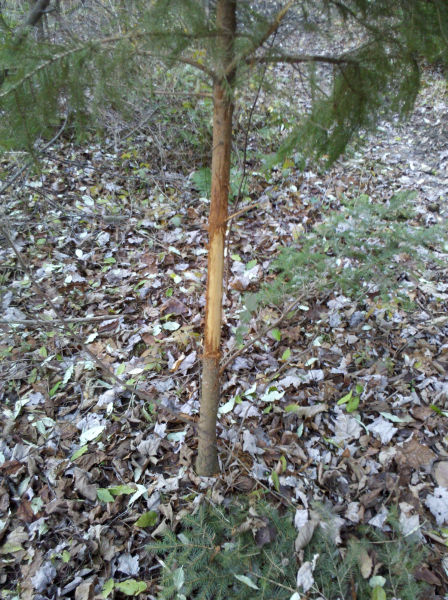
Today’s quiz should be easy for anyone who lives in Pennsylvania.
I found this damaged hemlock in Moraine State Park last weekend.
- What happened to this tree?
- Who did this? And why?
- Does this happen to trees of any size?
- Does this normally happen to hemlocks?
- Hardest question: What significance does tomorrow, November 29, have for this particular tree?
Post a comment with your answer.
p.s. I will be traveling today so you’ll see all the comments appear at once when I get to a computer and approve them.
(photo by Kate St. John)
A White-Tailed deer (buck) was rubbing velvet off of his antlers. That is why it is called a buck rub.
Bucks prefer to do this to tree saplings and branches. I would assume the reason is that the small size of the tree can get between the branches of the antlers.
A guess about the reason a buck will rub on hemlocks: because they are a soft wood? I have seen buck rubs on deciduous tree saplings.
November 29 is the first day of antlered deer season in PA. In some school districts (such as where I live in DuBois) it is an official “holiday” where no schools are in session. I don’t know if that is the answer to the last question due to the tricky “hemlock” part. 🙂
I see this damage in our yard and this it is worse than ever this year…I know it’s a buck rub and the tree will live IF it’s not rubbed (the bark) all the way around….I have been trees 8 to 10 inches round, with buck rubs or scrapes. I actually got to witness about a month ago, the buck who was doing this to my shrubs(willows, filberts, dogwoods, to name a few) and trees(alder, sumac, norway spruce, maple, aspen, sycamore and more)….looks like at last a 9 or 10 point but he was also in rut….Does would leave their scent (urine and in heat) where he rubs his antlers, and when he checks HIS areas, he scrapes and even paws the grass around…(I found pulled grass 3 to 5 feet away from the rub area)…after he smelled the scent, he followed the path of the doe(s) with his nose to the ground and tongue out, tail up, like a beagle on a rabbit scent. This buck is legal (has to have 4 points on one side in our area) and hopefully Dan will see it tomorrow for the first day of BUCK Season…something I did since I was 12, but quit after we moved here in 2001. Hunting is more than getting a deer…it was a quiet time for me, observing nature and learning patience of sitting still…I had deer, turkey and squirrels come with in a few feet of me….now I have it right in our yard to share with others. Just make sure if you are out, to wear the fluorescent orange, even a hat…this would NOT be a good time to be in the woods. Everyone be safe out there tomorrow.
I guess maybe it the deer rubbing off the velvet covering to the antlers and they eat the little twigs & maybe because this tree is small it doesn’t make it to Spring. And hunting opens tomorrow — stay out of the woods that day. No it is not the teddy bears’s picnic!!!! I know we need the hunters, we have too many deer but we have never learned wholly how to manage these herds & we & them have never learned to live together. We just build more houses. I wonder how the shale drilling affects this. Can’t be good for them to have something making noise in “their” woods 24/7. My son-law-comes up from Florida to hunt because he had previously lived up here & I warned him some of his spots may be have drilling rigs in them. But he usually checks his old hunting haunts prior. So many road kills. All that noise probably affects alot of birds.
A Bear maybe marking its territory?
Oh wait am I bad I didn’t notice how low to the ground that was,
that would be one short bear.
Hemlocks, hemlocks. We don’t have many hemlocks here in Rhode Island. Thanks to wooly adelgid (see http://www.dcnr.state.pa.us/forestry/woollyadelgid/index.aspx). Has wiped them out. I tried to have a lawn service save our tree (40 ft tall) by spraying some sort of oil every month. but it was too late and/or too ineffective.
need I mention that extinction sucks.
Faith, you are very astute in your observation about Marcellus shale gas drilling affecting wildlife.
Marcelllus drilling will definitely have an adverse affect on deer habitat. The forest fragmentation will also be detrimental to many birds who need continuous stretches of forest in which to live and breed.
As far as deer goes, they may drink contaminated/poisonous water from frack ponds. Would you eat a deer that drank that water, if it survives?
Shooting a firearm in the vicinity of a Marcellus well could trigger an explosion.
I am afraid that hunting in PA “as we know it now” is coming to an end.
Pronghorn Antelope (Wyoming area) have a 125 mile migration route that is 6,000 years old. In the film “Gasland”, I saw where shale gas fields hinder or obstruct their migration.
You can see pics and read more about the antelope’s migration here: http://news.nationalgeographic.com/news/2009/08/photogalleries/pronghorn-antelope-migration-missions-pictures/index.html
Marcy, thanks for the reminder to wear a flourescent orange vest while walking the dog in my woods tomorrow. (and the next couple of weeks)
Our land is posted No Trespassing and No Hunting, but ya never know….
Sunday was so busy that I forgot to confirm that yes, this is a buck rub. Marianne answered everything correctly in the first comment. What amazed me about this tree is that the buck picked a hemlock. I usually see this damage on deciduous trees.